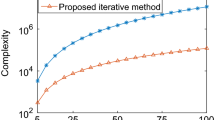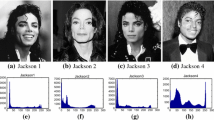Abstract
In many applications, such as biomedical engineering, it is often required to extract a desired signal instead of all source signals. This can be achieved by blind source extraction (BSE) or semi-blind source extraction, which is a powerful technique emerging from the neural network field. In this paper, we propose an efficient semi-blind source extraction algorithm to extract a desired source signal as its first output signal by using a priori information about its kurtosis range. The algorithm is robust to outliers and spiky noise because of adopting a classical robust contrast function. And it is also robust to the estimation errors of the kurtosis range of the desired signal providing the estimation errors are not large. The algorithm has good extraction performance, even in some poor situations when the kurtosis values of some source signals are very close to each other. Its convergence stability and robustness are theoretically analyzed. Simulations and experiments on artificial generated data and real-world data have confirmed these results.
Similar content being viewed by others
References
Cichocki A, Amari S. Adaptive Blind Signal and Image Processing: Learning Algorithms and Applications. New York: John Wiley Sons, 2002
Amari S, Cichocki A. Adaptive blind signal processing-neural network approaches. Proc IEEE, 1998, 86(10): 2026–2048
Hyvärinen A, Oja E. Independent Component Analysis. New York: Wiley, 2001
Ye Y L, Zhang Z L, Chen J, et al. A robust extraction algorithm based on a specific kurtosis value range. In: The 3rd International Conference on Natural Computation. Haikou, 2007. 49–53
Ye Y L, Zhang Z L, Chen J. A robust and non-invasive fetal electrocardiogram extraction algorithm in a semi-blind way. IEICE Trans Fund, 2008, E91-A(3): 916–920
Barros A K, Cichocki A. Extraction of specific signals with temporal structure. Neural Comput, 2001, 13(9): 1995–2003
Hansen LK, ÅNielsen F, Larsen J. Exploring fMRI data for periodic signal components. Artif Intell Med, 2002, 25(1): 35–44
Zhang Z L, Zhang Y. Extraction of a source signal whose kurtosis value lies in a specific range. Neurocomputing, 2006, 69(7–9): 900–904
Zhang Z L, Zhang Y. Extraction of temporally correlated sources with its application to non-invasive fetal electrocardiogram extraction, Neurocomputing, 2006, 69(7–9): 894–899
Lu W, Rajapakse J C. Approach and applications of constrained ICA. IEEE Trans Neural Netw, 2005, 16(1): 203–212
Barros A K, Vigário R, Jousmäki V, et al. Extraction of eventrelated signals from multichannedl bioelectrical measurements. IEEE Trans Biomed Eng, 2000, 47(5): 583–588
Hyvärinen A. Fast and robust fixed-point algorithm for independent component analysis. IEEE Trans Neural Netw, 1999, 10(3): 626–634
Zhang Z L, Zhang Y. Robust extraction of sepecific signals with Temporal Structure, Neurocomputing, 2006, 69(7–9): 888–893
Langley P, Bourke J P, Murray A. Frequency analysis of atrial fibrillation. Comput Cardiol, 2000, 27: 65–68
Rieta J J, Castells F, Sanchez C, et al. Atrial activity extraction for atrial fibrillation analysis using blind source separation. IEEE Trans Biomed Eng, 2004, 51(7): 1176–1186
Langley P, Rieta J J, Stridh M, et al. Comparison of atrial signal extraction algorithms in 12-lead ECGs atrial fibrillation. IEEE Trans Biomed Eng, 2006, 53(2): 343–346
Zhang Z L. Morphologically constrained ICA for extracting weak temporally correlated signals. Neurocomputing, 2008, 71(7–9): 1669–1679
den Hertog D. Interior Point Approach to Linear, Quadratic, and Convex Programming: Algorithms and Complexity. Kordrecht/Boston: Kluwer Academic, 1994
Nocedal J, Stephen W J. Numerical Optimization. Berlin: Springer Science + Business Media, Inc. 1999
Hyvärinen A. A family of fixed-point algorithms for independent component analysis. In: Proc IEEE Int Conf Axoustics, Speech, and Signal Processing. Munich, 1997. 3917–3920
Hyvärinen A, Oja E. Independent component analysis by general non-linear hebbian-like learning rules. Signal Process, 1998, 64(3): 301–313
Hampel F R, Ronchetti E M, Rousseuw P J, et al. Robust Statistics. New York: Wiley, 1986
Hyvärinen A. One-unit contrast functions for independent component analysis: A statistical analysis. In: Neural Networks Signal Processing VII, Proc IEEE Workshop Neural Networks for Signal Processing. 1997. 388–397
Cichocki A, Amari S, Siwek K, et al. ICALAB Toolboxes, http://www.bsp.brain.riken.jp/ICALAB
De Moor D ed. Daisy: database for the identification of systems, available online at: http://www.esat.kuleuven.ac.be/sista/daisy
De Lathauwer L, De Moor B, Vandewalle J. Fetal electrocardiogram extraction by blind source subspace separation. IEEE Trans Biomed Eng, 2000, 47(5): 567–572
Zarzoso V, Nandi A K. Noninvasive fetal electrocardiogram extraction: blind separation versus adaptive noise cancellation. IEEE Trans Biomed Eng, 2001, 48(1): 12–18
Author information
Authors and Affiliations
Corresponding author
Additional information
Supported by the National Natural Science Foundation of China (Grant No. 60702072), and China Scholarship Council
Rights and permissions
About this article
Cite this article
Ye, Y., Sheu, P.C.Y., Zeng, J. et al. An efficient semi-blind source extraction algorithm and its applications to biomedical signal extraction. Sci. China Ser. F-Inf. Sci. 52, 1863–1874 (2009). https://doi.org/10.1007/s11432-009-0163-0
Received:
Accepted:
Published:
Issue Date:
DOI: https://doi.org/10.1007/s11432-009-0163-0




